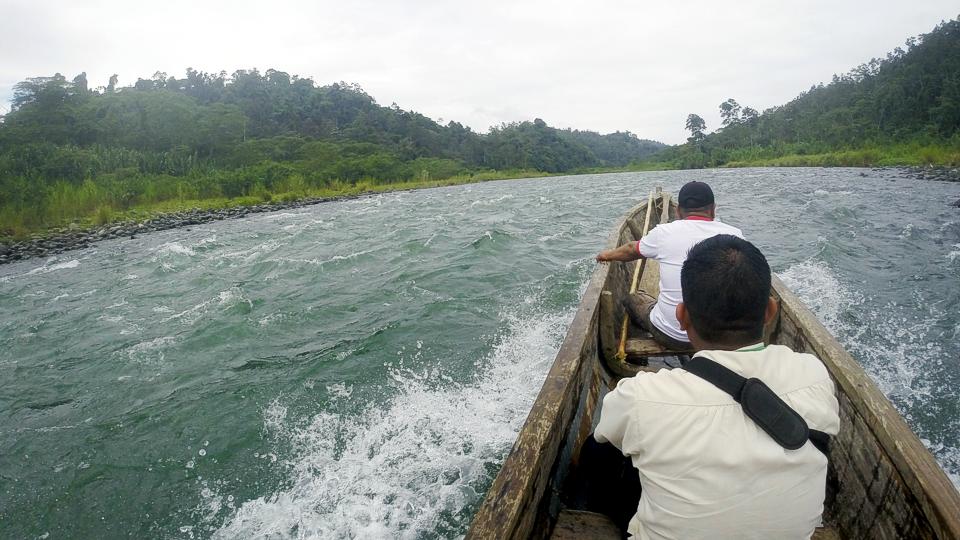From the high peaks of the Central Range to the clear waters of the Caribbean Sea, in addition to the archipelago, this territory is a true collection of landscapes, ecosystems and cultures that certify the tourism diversity of the beautiful Bocas del Toro Province.

Changuinola region comprises all territories between the Central Rage, Costa Rica, the Caribbean Sea and the Changuinola River basin, except the Teribe River, one of its tributaries.
There, most of the production of bananas and cocoa, livestock and agriculture is located. Its relationship with Costa Rica border adds additional aspects of its strong economy.
In the main city, Changuinola, are concentrated businesses, banks, shops and commerce associated with the resulting economic power.
However, with the use of land for production, there are areas in which have tried to conserve valuable ecosystems that are home to species of global importance, such as manatees, sea turtles, the harpy eagle and many more.
These spaces are also attractive for tourism, an emerging tourism that is still waiting for entrepreneurs to invest in that future.

Both sides of the Teribe River, from upstream until it empties into the Changuinola River, are populated by one of the most enigmatic native peoples of our country, the Naso Tjer Di.
They inhabit the river that their ancestors have called Tjer Di and which is the basis of their life. They are the only ones in America to be ruled by a king.
The river of the Naso has formed a valley between two mountain formations derived from the Central Range and all activities are developed in relation to the, many times, rushing waters of the same.
In this river is the begining of two important protected areas: La Amistad International Park and Palo Seco Protector Forest, both involved in protecting ecosystems and species of that Range.
The Naso Tjer Di are very proud of their culture and demonstrate it with their handicrafts, dances, meals. Tourism is already a regular part of their activities.

Recently declared new provincial district occupies the territory limited by the District of Changuinola, to the west, Chiriqui Grande District to the east, the Almirante Bay to the north and the Central Mountains Range to the south.
It has a huge potential that can now have a chance to develop, as its location in the province is very strategic: is the passage of the tourism that goes to the archipelago, either coming by land from Costa Rica or the rest of Panama. One of the main roads that connects Bocas del Toro and Chiriqui provinces and the Pan American Highway, cross it completely.
There also arrive goods necessary for the archipelago.
In the valleys formed between this road (Punta Pena-Almirante) and the mountains of the Central Range, there are numerous Ngabes villages wich dependend, in many cases, of their survival production. Some tourist attractions are beginning to develop in this region.
Its port, besides being the embarkation point for tourists traveling to the Archipelago, the bananas produced in the province with destination of Europe, is the second choice of communication by sea for the inhabitants of the coast of the Comarca Ngabe-Bugle.

The port of Chiriqui Grande, at the end of the road between Gualaca in the province of Chiriqui and this point of Bocas del Toro coastline, on the shores of Laguna de Chiriqui, has seen better days, when terrestrial communications between the Country and the Province finalized here.
At that time, about 15 years ago, all was focused on this population, mainly maritime transportation to the Archipelago and Almirante. To this was linked the distinction of being the Caribbean Terminal of the Transisthmian Pipeline which starts at Puerto Armuelles, Chiriqui.
Today, although the port continues to maintain this activity the oil transfer, after being built the Punta Pena-Almirante road, the other functions are no longer used, except to be the first choice of communication with coastal villages of Comarca Ngabe-Bugle. For these reasons, the town of Chiriqui Grande is often overlooked by tourists.
However, this region is not only the harbor: like in Almirante, at the mountains exist numerous Ngabes communities living of their production to sustain itself. Beautiful scenery in the mountains, with rain and wet forests are potential tourist attractions.


